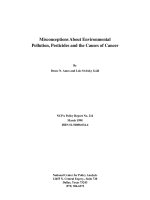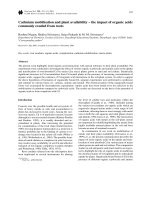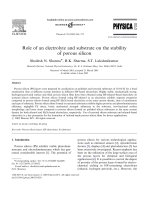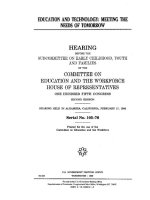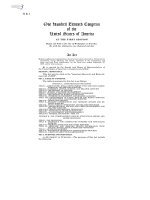- Trang chủ >>
- Khoa Học Tự Nhiên >>
- Vật lý
catastrophes and lesser calamities the causes of mass extinctions jul 2004
Bạn đang xem bản rút gọn của tài liệu. Xem và tải ngay bản đầy đủ của tài liệu tại đây (2.15 MB, 241 trang )
Catastrophes and lesser calamities
The causes of mass extinctions
Tony Hallam is Emeritus Professor of Geology at the
University of Birmingham and the author of a huge
range of scientific books and papers including
Great Geological Controversies (1992) and
Mass Extinctions and their Aftermath
(with Paul Wignall, 1997).
This page intentionally left blank
Catastrophes and
lesser calamities
The causes of mass extinctions
Tony Hallam
1
3
Great Clarendon Street, Oxford OX2 6DP
Oxford University Press is a department of the University of Oxford.
It furthers the University’s objective of excellence in research, scholarship,
and education by publishing worldwide in
Oxford New York
Auckland Cape Town Dar es Salaam Hong Kong Karachi
Kuala Lumpur Madrid Melbourne Mexico City Nairobi
New Delhi Shanghai Taipei Toronto
With offices in
Argentina Austria Brazil Chile Czech Republic France Greece
Guatemala Hungary Italy Japan Poland Portugal Singapore
South Korea Switzerland Thailand Turkey Ukraine Vietnam
Oxford is a registered trade mark of Oxford University Press
in the UK and in certain other countries
© Oxford University Press 2004
The moral rights of the author have been asserted
Database right Oxford University Press (maker)
First published 2004
First published in paperback 2005
All rights reserved. No part of this publication may be reproduced,
stored in a retrieval system, or transmitted, in any form or by any means,
without the prior permission in writing of Oxford University Press,
or as expressly permitted by law, or under terms agreed with the appropriate
reprographics rights organization. Enquiries concerning reproduction
outside the scope of the above should be sent to the Rights Department,
Oxford University Press, at the address above
You must not circulate this book in any other binding or cover
and you must impose this same condition on any acquirer
British Library Cataloguing in Publication Data
Data available
Library of Congress Cataloging in Publication Data
Data available
Typeset by Footnote Graphics Limited, Warminster, Wiltshire
Printed in Great Britain
on acid-free paper by
Clays Ltd., St Ives plc
ISBN 0–19–280668–8 (Pbk.) 978–0–19–280668–0 (Pbk.)
1
Preface
When I accepted an invitation from the Oxford University
Press to write a popular account of mass extinctions, I had two
things primarily in mind. Firstly, I had become somewhat
exasperated over the years, as had many of my colleagues, by
the unbalanced and over-sensationalized treatment of the sub-
ject of mass extinctions by the media, including respectable
broadsheet newspapers and television channels. This was of
course the direct consequence of the remarkable discoveries of
an iridium anomaly and shocked quartz at the Cretaceous–
Tertiary boundary, apparently coinciding with the extinction
of the dinosaurs. This led to the interpretation of a spectacular
deterioration of the global environment as a consequence of
the impact of an asteroid about 10 kilometres in diameter. The
combination of dinosaur extinction and asteroid impact has
proved irresistible to science journalists, who are always under
pressure from their editors to produce sensational material
that will interest the general public.
As a direct consequence of this research on Cretaceous–
Tertiary boundary strata, there has been a tendency among
some very able scientists, both within and outside the Earth-
science community, to ascribe many or even all catastrophic
mass-extinction events to the impact of asteroids or comets,
and much attention has been given to the prospect of future
Armageddon induced by phenomena from outer space. All
this has meant that events produced by changes solely con-
fined to our own planet have been underplayed by both the
public and many otherwise well-informed scientists. This book
is intended to redress the balance and put impacts within the
context of a number of purely Earth-bound events that have
evidently affected the biosphere severely on a number of
occasions in the geological past.
The second matter concerns the ignorance of the general
public, however intelligent or well educated they may be in
other respects, about how geologists and palaeontologists
study mass-extinction events from data they extract from the
geological record across the world. I have thus tried to give at
least an elementary idea about how they go about this, and
how ideas or speculation are put to the test, which is of course
the essence of the scientific method. I thus hope to improve
understanding to some degree, while remaining aware that in
any subject there are degrees of understanding. For those who
wish to learn more, there is a list of references at the end of the
book with suggestions for further reading. I hope also that,
besides interested members of the general public, profession-
als and students in the Earth sciences, together with some
biologists, who wish to know more about mass-extinction
studies, may derive some benefit from the book.
There are many people I could thank, but I shall confine
myself to mentioning just a few. I derived great stimulation
from various conferences across the world from the mid-1980s
to the early 1990s, when the debate on the end-Cretaceous
extinctions was at its height, and I am rather proud of the fact
that I have maintained good personal relations with some of
the leading antagonists, such as Walter Alvarez and Frank
Asaro on the one hand, and Charles Officer and the late
Charles Drake on the other. Subsequent meetings have paid
more attention to other mass-extinction horizons, most notably
that at the Permian–Triassic boundary. Although I have
sometimes disagreed strongly with Dave Raup, I have always
appreciated and have, I hope, sometimes benefited from the
lucidity of his thinking on many topics. Mike Benton has
exhibited an impressive and rather rare mixture of focusing on
critical detail and having an awareness of the big picture. I
have greatly appreciated the work of Richard Fortey and the
late Steve Gould, not just for the general excellence of their
popular science writing but for their free use of personal
vi Preface
anecdote to enliven the text, which has influenced my own
style. Most of all I thank my good friend and colleague Paul
Wignall for his stimulating company and wise thoughts. Bruce
Wilcock proved a most percipient copy editor, for which I am
duly grateful. Finally, I am greatly indebted to June Andrews
for her invaluable secretarial help.
A.H.
Birmingham
February 2003
Preface vii
This page intentionally left blank
Contents
List of illustrations x
1 In search of possible causes of mass extinctions 1
2 Historical background 8
3 Evidence for catastrophic organic changes in the
geological record 19
4 Impact by comets and asteroids 39
5 Sea-level changes 65
6 Oxygen deficiency in the oceans 91
7 Climate change 108
8 Volcanic activity 130
9 Pulling the strands together 148
10 The evolutionary significance of mass extinctions 167
11 The influence of humans 184
Notes and suggestions for further reading 203
Bibliography 208
Glossary 214
Index 221
Note
In this book ‘billion’ denotes a thousand million (1000,000,000 or 10
9
);
‘trillion’ a million million (1,000,000,000,000 or 10
12
).
List of illustrations
Fig. 1.1 Two dinosaurs of the Jurassic and Cretaceous periods.
(a) Stegosaurus (Jurassic). (b) Tyrannosaurus (Cretaceous).
These illustrate the very different dinosaur faunas of the
two eras.
(a) The Natural History Museum, London/Orbis,
(b) The Natural History Museum, London/J Sibbick.
Fig. 2.1 Georges Cuvier (1769–1832).
Fig. 2.2 Sir Charles Lyell (1797–1875).
Fig. 2.3 Charles Darwin (1809–1882). This portrait was drawn
when Darwin was better known as a geologist than as a
biologist.
Fig. 2.4 William Thomson, Lord Kelvin (1824–1907).
Fig. 3.1 Timescale for the Phanerozoic eon. Ages are shown in
millions of years.
Fig. 3.2 Example of fossils of high biostratigraphic value.
(a) An Ordovician graptolite. (b) A Cretaceous ammonite.
(a) Martin Land/Science Photo Library,
(b) Oxford University Museum of Natural History.
Fig. 3.3 Diagram to illustrate how a stratigraphic hiatus can create a
false impression of a mass extinction from a continuous set of
species ranges, represented by vertical bars. The left-hand
portion of the diagram (a) exhibits continuous sedimentation,
but in the right-hand portion (b) the band marked by oblique
lines has been removed by erosion or non-sedimentation.
Fig. 3.4 The Signor–Lipps effect: the effect of random range
truncations on an abrupt mass extinction. Artificial range
truncations produce an apparently gradual extinction.
Fig. 3.5 The difference between traditional and cladistic methods of
classification, illustrated by reference to three familiar
vertebrates. In the traditional method (a) closeness of
evolutionary affinity is determined by degree of
morphological resemblance, whereas in the cladistic method
(b) it is determined by recency of common ancestry.
Fig. 4.1 Whole-rock iridium profile across 57 metres of
Maastrichtian–Palaeocene limestones at Gubbio, Italy, formed
in the open sea by the slow accumulation of sediments. The
beds depicted represent about 10 million years of deposition.
A pronounced iridium anomaly occurs in a clay layer 1
centimetre thick exactly at the Cretaceous–Tertiary (K–T)
boundary. This peak of 300 parts per trillion (ppt) of iridium
is flanked by ‘tails’ with iridium concentrations of 20–80 parts
per trillion that rise above the background level of 12–13 parts
per trillion. The fine structrure of these tails is the result of
diffusion and burrowing by organisms. (Simplified from
Alvarez et al. (1990).)
Fig. 4.2 An example of shocked quartz, displaying the characteristic
multiple sets of planar features known as shock lamellae.
G. A. Izett/US Geological Survey.
Fig. 4.3 Map of the Gulf of Mexico–Caribbean region showing the
location of the purported Chicxulub crater and the
approximate location of the coastline at the end of the
Cretaceous period. (From A. Hallam and P. Wignall, Mass
extinctions and their aftermath, Oxford University Press, 1997.)
Fig. 5.1 Photograph looking eastwards towards Lulworth Cove,
Dorset, a county where the magnificent Jurassic and
Cretaceous cliffs have been designated a World Heritage Site.
The rocks forming the headland consist of alternating
limestones and shales of the Lulworth Formation straddling
the Jurassic–Cretaceous boundary, which were deposited in a
marginal marine-to-lagoonal environment. (These sediments
are traditionally known as part of the Purbeck Beds.) They are
overlain by soft-weathering silts, sands, and clays of the early
Cretaceous Wealden Beds, also non-marine, into which the
cove has been excavated by the sea. They pass up into shallow
marine greensands and then into deeper-water marine Chalk,
signifying a more or less progressive rise of sea level from the
early to the mid-Cretaceous. Stair Hole in the foreground
shows tectonically disturbed Purbeck Beds, known as the
Lulworth Crumple.
Fig. 5.2 The global extent of the mid-Cretaceous marine transgression,
about 100 million years ago. Stippled areas indicate land.
(After Alan G. Smith, David G. Smith, and Brian M. Funnell,
Atlas of Mesozoic and Cenozoic coastlines, Cambridge University
Press, 1994, p. 38.)
List of illustrations xi
Fig. 5.3 The location of Newell’s six major episodes of marine mass
extinction, marked by asterisks, with respect to Hallam’s
first-order Phanerozoic sea-level curve. (After Hallam and
Wignall (1997).)
Fig. 6.1 An excellently preserved ichthyosaur, a swimming reptile,
from the Lower Jurassic Posidonia Shales of Holzmaden,
south-west Germany. Not only have the bones not been
disarticulated by scavengers after death, but the outline of the
original soft parts is preserved as a black carbonaceous film.
Staatliches Museum für Naturkunde, Stuttgart.
Fig. 6.2 Schematic representation of three oxygen-related biofacies. In
order of decreasing levels of bottom-water oxygenation these
are (1) oxic, (2) dysoxic, and (3) anoxic. Note the reduction of
diversity, burrow diameter, and vertical extent of biogenic
structures with decreasing oxygenation within zone 2. Zone 3
is characterized by laminated sediments poor in benthos; zone
2 by partly laminated or fissile sediments with a limited
benthos: zone 1 by thoroughly bioturbated sediment rich in
benthos, including a variety of active burrowers.
Fig. 7.1 Varying oxygen isotope ratio of foraminifera through the past
70 million years. Higher values of ␦
18
O signify lower
temperatures.
Fig. 7.2 Sharp negative shift of both the oxygen and the carbon
isotope ratios in foraminifera at the Palaeocene–Eocene
boundary. Isotope ratios are in parts per thousand (‰).
Fig. 8.1 An example of a nuée ardente photographed in Martinique.
GeoScience Features Picture Library.
Fig. 8.2 The Columbia River of the American Northwest traverses the
Columbia Plateau lavas of Miocene age, an example of a flood
basalt province.
F. O. Jones/US Geological Survey.
Fig. 8.3 Effects of volcanic gases and the time intervals over which
they operate. With the exception of CO
2
, most gases are
rapidly removed from the atmosphere and are thus liable to
affect the weather rather than long-term climate.
(After Wignall (2001). Reproduced by permission.)
Fig. 8.4 Global distribution of continental flood-basalt provinces and
oceanic plateaux. CAMP, Central Atlantic Magma Province.
(After Wignall (2001). Reproduced with permission.)
Fig. 9.1 Summary of the proposed causes of the main Phanerozoic
mass-extinction events.
xii List of illustrations
Fig. 10.1 What the fossil record in a stratal succession may reveal for
(a) displacive and (b) pre-emptive competition.
Fig. 10.2 Logistic model (a) and exponential model (b) to be tested
against data from the fossil record.
Fig. 10.3 The changing diversity of (a) marine and (b) continental
families through the Phanerozoic and back into the latest
Precambrian (Vendian). In both (a) and (b) an exponential
curve extending back to 600 million years is portrayed.
For continental organisms this curve is closely coincident
with one for the past 250 million years. (Simplified from
Hewzulla et al. (1999).)
Fig. 11.1 The moa of New Zealand, a giant flightless bird related to the
emu and ostrich, which was rendered extinct by Maori
immigrants.
The Natural History Museum, London.
List of illustrations xiii
This page intentionally left blank
1
In search of possible causes of
mass extinctions
When the subject of extinctions in the geological past comes
up, nearly everyone’s thoughts turn to dinosaurs. It may well
be true that these long-extinct beasts mean more to most
children than the vast majority of living creatures. One could
even go so far as to paraphrase Voltaire and maintain that
if dinosaurs had never existed it would have been necessary
to invent them, if only as a metaphor for obsolescence. To refer
to a particular machine as a dinosaur would certainly do
nothing for its market value. The irony is that the metaphor is
now itself obsolete. The modern scientific view of dinosaurs
differs immensely from the old one of lumbering, inefficient
creatures tottering to their final decline. Their success as domi-
nant land vertebrates through 165 million years of the Earth’s
history is, indeed, now mainly regarded with wonder and even
admiration. If, as is generally thought, the dinosaurs were killed
off by an asteroid at the end of the Cretaceous, that is some-
thing for which no organism could possibly have been pre-
pared by normal Darwinian natural selection. The final demise
of the dinosaurs would then have been the result, not of bad
genes, but of bad luck, to use the laconic words of Dave Raup.
In contemplating the history of the dinosaurs it is necessary
to rectify one widespread misconception. Outside scientific
circles the view is widely held that the dinosaurs lived for a
huge slice of geological time little disturbed by their environ-
ment until the final apocalypse. This is a serious misconcep-
tion. The dinosaurs suffered quite a high evolutionary turnover
rate, and this implies a high rate of extinction throughout their
history. Jurassic dinosaurs, dominated by giant sauropods,
stegosaurs, and the top carnivore Allosaurus, are quite differ-
ent from those of the Cretaceous period, which are character-
ized by diverse hadrosaurs, ceratopsians, and Tyrannosaurus
(Figs. 1.1a؉b). Michael Crichton’s science-fiction novel Jurassic
Park, made famous by the Steven Spielberg movies, features
dinosaurs that are mainly from the Cretaceous, probably
because velociraptors and Tyrannosaurus could provide more
drama. The implication of all this is that while there is no doubt
that the dinosaurs suffered a major catastrophe at the end of
their reign on Earth, it need not necessarily have been signifi-
cantly more severe than a number of other events throughout
their history. Unfortunately the fossil record for the dinosaurs
is so patchy and limited that it is difficult at present to say
much of note about such events.
Interest in the subject is reflected in the numerous hypothe-
ses that have been put forward over the years to explain the
extinction of the dinosaurs at the end of the Cretaceous period.
Alan Charig, a former curator of fossil reptiles in the Natural
History Museum, London, reckoned that he had discovered
more than ninety, most of them more or less fanciful. They
include climatic deterioration, disease, nutritional problems,
parasites, internecine fighting, imbalance of hormonal and
endocrine systems, slipped vertebral discs, racial senility, mam-
mals preying on dinosaur eggs, temperature-induced changes
in the sex ratios of embryos, the small size of dinosaur brains
(and consequent stupidity), and suicidal psychoses. Perhaps
the most fanciful of all appeared in the late 1980s in a letter to
the Daily Telegraph, from a scientist respectable enough in his
own field. He thought that the dinosaurs had died out as a
consequence of an AIDS infection induced by viruses intro-
duced from outer space. One of my favourites relates the
demise of the dinosaurs to the decline in the Cretaceous of
the naked seed plants, or gymnosperms, at the expense of the
flowering plants, the angiosperms. Surviving gymnosperms,
2 In search of possible causes of mass extinctions
which include cycads (palm-like trees) and conifers, commonly
contain fluids with renowned purgative properties. The impli-
cation, then, is that the herbivorous dinosaurs died of con-
stipation. The problem with this hypothesis is that the main
floral turnover took place about 35 million years too early. I
used to recount this hypothesis in a course on the elements of
historical geology that I gave to a class of first-year geography
students at Oxford. It wasn’t just for the usual lecturer’s trick
of raising a laugh (which it always did) to keep the attention of
the class, but to make a serious scientific point, which was that,
unlike most of the ad hoc speculations that have passed as
extinction hypotheses, this one could be tested against the
stratigraphic record – and found wanting. Two other conse-
quences are worth recounting. About twenty years after he had
attended my course, a man approached me at a conference. He
was polite enough to tell me how much he had enjoyed the
lectures, but he then rather spoiled the effect by admitting that
the dinosaur joke was the only thing about them that he had
remembered. The other outcome is that, as a result of a short
article I wrote repeating the story, two popular science books
In search of possible causes of mass extinctions 3
Fig. 1.1a Two dinosaurs of the Jurassic period.
have been published in the United States that attribute the
authorship of the ‘constipation hypothesis’ to me . . .
As the spread of an epidemic disease has so often been
invoked for the extinction of the dinosaurs (and indeed of
other groups), the subject of disease as an extinction mech-
anism needs to be addressed. The onset of the Black Death
throughout Europe in the mid-fourteenth century undoubt-
edly ranks as a catastrophe by anyone’s reckoning, but the
human race did not become extinct as a consequence. The
same applies to pandemics, such as the outbreak of influenza
that swept through Europe and America in 1918, reaching the
remote wastes of Alaska and the most isolated of island com-
munities. It is estimated that half the world’s population was
infected, and that of those infected one in twenty died. Most of
4 In search of possible causes of mass extinctions
Fig. 1.1b Dinosaurs of the Cretaceous period.
the fatalities were among teenagers and young adults. This
compares with a death rate of one per thousand in other flu
pandemics, in which most of those who die are either very
young or very old. The 1918 ‘Asian’ flu virus was evidently
one of unusual virulence but, catastrophe though it undoubt-
edly was, our species survived.
A third example is the smallpox virus that was carried to
the Americas, the whole of Africa, Australia, and New Zealand
by European settlers and invaders. In each of these territories
the indigenous population suffered terribly because of their
total lack of resistance. In some places the disease killed up to
half the population and had a significant influence on world
history. Thus, probably a third of the Aztecs were killed by
smallpox, allowing Cortez an easy victory. The Aztec peoples
did not, however, become extinct and today their descendants
dominate the population of Mexico.
The key point, of course, is that even in the most cata-
strophic epidemics or pandemics caused by viruses or bacteria
a proportion of the infected population either already posses-
ses or in the course of time acquires immunity through adapt-
ation. Thus, whereas the Europeans had lived with the
smallpox virus for centuries, it was new to peoples in other
parts of the world. Within Europe there have been repeated
outbreaks of the plague throughout the course of history, but
after the Black Death its significance as a mass killer was in
decline long before there were widespread improvements in
housing or sanitation.
A striking illustration of adaptation comes from the man-
made epidemic of myxomatosis in rabbits. The myxomatosis
virus, which naturally infects Brazilian rabbits and causes
them little harm, was introduced into Australian rabbits
(which were originally introduced from Europe) in 1950 in a
deliberate attempt to control their ever-increasing numbers.
The virus initially had the devastating effect that was intended;
in the first year it killed 99.8 per cent of infected rabbits, but the
effect soon wore off, and seven years later only 25 per cent of
infected rabbits were dying. Now, half a century later, rabbits
In search of possible causes of mass extinctions 5
are back to full strength in Australia. Since the generation time
of a rabbit is only 6–10 months, compared to 20–30 years for
humans, in a similar situation it would take us 120–150 years
to adapt to a new killer virus.
It follows that it is extremely unlikely, indeed virtually
impossible, for a particular disease, however devastating, to
cause a species to become extinct. The situation is even more
pronounced for mass extinctions, because it is unusual for
diseases to cross species barriers freely. Despite the current
concern about the possibility of BSE being transferred from
cattle to humans in the form of new variant CJD, and the
likelihood that the AIDS virus was originally transmitted to
humans in Africa from apes or monkeys, the groups in
question are all mammals, and hence are closely related in an
evolutionary sense. Microbial transfers of this kind are gener-
ally perceived as exceptional. Disease can thus be ruled out
as a plausible mechanism to account for mass extinctions,
which by definition have simultaneously affected a whole
variety of organisms, both terrestrial and marine, of widely
differing biology. The clear implication is that such extinctions
must have involved deleterious changes in the physical
environment. There is indeed no serious argument on this
point among the scientists who study mass extinctions, but
plenty of argument about just what these changes were, and
about the most likely ultimate cause.
The next point that needs to be established is that, to be
really effective, the environmental changes must have been
on a global scale. If they were merely regional, the areas of
refuge for the survivors would have been far too extensive, and
they might subsequently have expanded their geographical
range once conditions had ameliorated. Furthermore, the
environmental deterioration could have been effective in two
ways. It could have been short-lived but so severe that only
a limited proportion of organisms survived. Alternatively it
might have been less severe but more sustained in time so that,
to quote T. S. Eliot’s lines in The Hollow Men, organisms died
out ‘not with a bang but a whimper’. Clearly this is highly rele-
6 In search of possible causes of mass extinctions
vant to the subject of how catastrophic the mass-extinction
events were, and the possible causal mechanism.
There are in fact only a few geological phenomena that can
plausibly be invoked. The problem is to discriminate between
them: one particular phenomenon can have multiple environ-
mental effects on a global scale. Impacts by comets or asteroids,
sea-level changes, and volcanism can all affect climate, and
climatic change can affect sea level and the degree of oxygen-
ation of the ocean water. Disentangling the critical factor can be
difficult, and some people have been tempted to throw up their
hands and admit a role for every factor that might be relevant.
This can be called the Murder on the Orient Express scenario,
after the celebrated Agatha Christie whodunnit in which the
final resolution turns out to be that everybody did it. Other
writers have promoted one factor as the dominant, if not
the only, cause of all mass extinctions, both major and minor.
The approach preferred here is to attempt to steer a course,
Odysseus-like, between the Scylla of one overriding cause and
the Charybdis of an unresolved multiplicity of causes.
A historical science like geology suffers from the limitation
that it is not amenable to experimental test. Indeed, Karl
Popper, the philosopher who is well known among scientists
for his criterion of falsifiability, argued that for this reason the
historical sciences (which include evolutionary science) hardly
rank as proper science at all. Popper’s falsifiability criterion
has, however, been attacked by other philosophers as being
over-simplistic, and a consensus has emerged that the true dis-
tinction between science and myth is that science is amenable
to objective testing of its hypotheses, whether by experiment
or by observation. The types of observation that are relevant to
the study of mass extinctions are mainly concerned with the
association with other phenomena that can be recognized in
the stratigraphic record. These topics provide the subject
matter for later chapters. Before that, however, we need to
consider the historical background to thought on extinctions
and catastrophes. We shall then be better able to evaluate the
significance of modern research on these events.
In search of possible causes of mass extinctions 7
2
Historical background
Georges Cuvier has not been treated with much respect in the
English-speaking world for his contributions to the study of
Earth history. Charles Lyell is thought to have effectively
demolished his claims of episodes of catastrophic change in the
past, and it is only in the past few decades, with the rise of so-
called ‘neocatastrophism’, that a renewed interest has emerged
in his writings, which date from early in the nineteenth century.
Cuvier was a man of considerable ability, who quickly rose
to a dominant position in French science in the post-Napoleonic
years (Fig. 2.1). Though primarily a comparative anatomist,
his pioneer research into fossil mammals led him into geology.
He argued strongly for the extinction of fossil species, most
notably mammoths, mastodons, and giant sloths, at a time
when the very thought of extinctions was rather shocking to
conventional Christian thought, and linked such extinctions
with catastrophic changes in the environment. This view is
expressed in what he called the ‘Preliminary Discourse’ to his
great four-volume treatise entitled Recherches sur les Ossements
Fossiles (Researches on fossil bones), published in 1812. This
extended essay was immensely influential in intellectual
circles of the western world, was reissued as a short book,
and was repeatedly reprinted and translated into the main
languages of the day. It became well known in the English-
speaking world through the translation by the Edinburgh
geologist Robert Jameson (1813), who so bored the young
Charles Darwin with his lectures that he temporarily turned
him off the subject of geology. According to Martin Rudwick,
who has undertaken a new translation which is used here,
Jameson’s translation is often misleading and in places down-
right bad. It was Jameson’s comments rather than Cuvier’s
text that led to the widespread belief that Cuvier favoured a
literalistic interpretation of Genesis and wished to bolster the
historicity of the biblical story of the Flood.
The English surveyor William Smith is rightly credited with
his pioneering recognition of the value of fossils for correlating
strata, which proved of immense importance when he pro-
duced one of the earliest reliable geological maps, of England
and Wales, but the more learned and intellectually ambitious
Cuvier was the first to appreciate fully the significance of
fossils for unravelling Earth history. Whatever his attractive
qualities, modesty was not one of them, and he hoped to do for
the dimension of time what Newton and his French com-
patriot Laplace had achieved for space. In essence he laid
down a research programme based on the use of fossils found
in successions of rock strata, which he treated as historical
Historical background 9
Fig. 2.1
Georges Cuvier (1769–1832).
documents, at a time when geologists were still trying to estab-
lish correlations by means of the rocks themselves. His pro-
gramme entailed studying the youngest and most familiar
rocks and fossils first, and working backwards through time.
His own field experience was effectively limited to the rela-
tively young Quaternary and Tertiary strata of the Paris Basin
in northern France, where his research was done in collabora-
tion with his Parisian colleague Alexandre Brongniart. It was
Brongniart who was able in 1821 to demonstrate the presence
of Cretaceous fossils at an altitude of about 2000 metres in
the Savoy Alps and of fossils resembling those of the Tertiary
deposits of the Paris Basin high in the Vicentine Alps. This
work clearly indicated for the first time that some mountains
must, in geological terms, be young in age.
In his Preliminary Discourse, Cuvier pointed out that the
lowest-lying strata we see are full of marine shells, indicating
that the sea had invaded the plains and stayed there peacefully
for a long time. At the feet of mountains, however, the strata
become tilted, and the species they contain are different from
those found in younger rocks. These tilted beds form the crests
of what in Cuvier’s time were called the ‘secondary mountains’,
and plunge below the horizontal beds of hills that form their
feet. Some unspecified cause had broken, tilted, or otherwise
disturbed them. The catastrophe that made these beds oblique
had also thrust them above sea level. Fossil species and even
genera changed with the successive beds or strata. In the middle
of the marine beds there are other beds containing only terres-
trial and freshwater plants or animals. Thus the successive
catastrophes of our planet have caused alternations of marine
and terrestrial conditions. The catastrophes that led to such
changes have been sudden. Cuvier chose the fossil mammoths,
which had then recently been discovered, as an example.
Because many such mammoths known from northern Siberia
are well preserved today, there must have been a very rapid
cooling of the climate to preserve them. The tearing and
upheaval of beds that happened in earlier catastrophes were as
sudden and violent as the latest one. Masses of debris and rolled
10 Historical background

